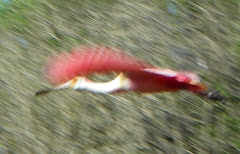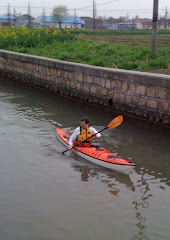Learning to feel. Blind people learn to read Braille with their fingertips, rapidly scanning patterns of bumps, gathering meaning as I do when I sight-read a book. On the street, a blind person surveys their surroundings with a cane.
So, how much information about the water does a kayaker or canoeist gather in this way from their paddle? As a beginner, only a little, but more with practice.
Imagine standing with your paddle on the end of a dock with your eyes shut. You reach down to dip your paddle into a current flowing past the end of a dock. You should be able to feel the direction of the current, and whether the current is fast or slow, and if the water is turbulent. Would you be able to feel if there are waves? If so, could you gauge their size, and direction? Imagine holding your paddle lightly in your fingers, and then with a fist grip. Which offers the more sensitivity?
 |
|
A light grip offers most sensitivity. |
A light grip is key to fine blade control. It allows us to tweak the blade alignment to get the maximum grip against the current. Holding gently, we feel whenever the blade starts to pendulum, or trembles dragging against the current. We can twist the blade, edge-on to the current to find its angle of least resistance and steer it through tumbling currents while maintaining least resistance. It is easier to be accurate when we have a loose rather than tight grip.
 |
|
Keep a loose hand grip. |
Just as we rarely look at our feet when walking, we do not watch our paddle constantly when we kayak; we mostly look ahead. We feel the water through the paddle. Sure, our sight and hearing reinforce or confirm what we feel, but we cope surprisingly well in the dark, or when our hearing is impaired by hat or helmet, or when we paddle with our eyes shut.
So, how different will the water feel when we transfer from dock to kayak? While the dock stays fixed, our kayak moves. We place the blade to pull ourselves forward, to push back, or to turn. When we do this, do we feel the water as if it were something solid to lever against, or something that gives, letting our blade drag as it did when we stood on the dock? Or do we feel a bit of both? What happens when we pull our paddle hard against the water, compared to when we pull gently?
 |
|
Feel how the blade interacts with the water. |
Confronting such questions will help us understand what is going on and help us maximize the effect of our paddle. Pull or push the paddle hard and the water moves. Better use that energy to move the kayak, not the water. To be efficient, we should minimize how much water we move, while maximizing how much we move the kayak. We find that balance by feel.
Only then can we can choose whether to use our energy to move water or not. Beyond a certain point, more exertion churns the water, making noise but adding little to our speed. When we ease off until our paddle strokes become quiet, we move very little water, sacrifice only a little speed, and save a lot of energy.
 |
|
Feel how the blade reacts in the water, and how the kayak responds, then tweak the angle accordingly. |
Blade alignment
Whitewater slalom competitors work to maintain optimum blade alignment through complex turns in turbulent water. Imagine underwater you are trying to catch the current in your hand. You can move your hand to find the angle at which the pull of current is strongest. Whitewater paddlers feel and take advantage of the changing direction and strength of currents, feeling the water through the palms of their paddle blades. To cross an eddy line, they must get their angle of approach right, make precision blade placements, and nail their timing. They constantly adjust blade angles to best catch the currents, which swirl and surge. With experience, they anticipate those currents, but they fine-tune by touch.
 |
|
Look where you are going and feel the water with your blade. |
With practice, many of the details they feel, and act upon, become so familiar they blend to become automatic. The changes in water pressure on the blade trigger unconscious responses.
 |
|
You rarely need a fist-tight grip. |
Watch an expert play on a rapid and everything looks effortless, as if the current slows down for them. Most of their sensing and responding is done unconsciously. They work with the water. In contrast, a beginner in the same space often fights the water. Overwhelmed by the burden of consciously gathering and processing all the details, paddling become crisis management. So, how do we best progress from fighting the water to working with it?
Here are some tips:
1. Much of paddle control is done by feel. Learn what to feel for. A good instructor should be able to guide you.
2. Listen to your paddle. It makes more noise when you move water.
2. Focus on feeling the water through your paddle with every stroke. A light grip with fingertip control will enable the most feedback.
3. Note what you feel, then try to put it into words. For example, you might observe: “the paddle starts to shake toward the end of my paddle stroke”. Or: “I splash water at the start of each stroke.” Awareness is crucial.
4. Question each effect you notice and decide if it is desirable. Will your stroke be more effective if you try to make this happen more, or less? How would you achieve either outcome?
5. Aim to move the kayak rather than the water.
When you apply your skills to the waters you wish to paddle, whether calm or rowdy, always question what is going on. Once you can interpret, evaluate, and respond to all the signals that come from the water through the paddle, the paddle will become an extension of your body. Use your paddle to seek maximum effect for minimum effort, and work in harmony with the water.
 |
|
You can learn a lot even without your kayak.
Learn more from my book The Art of Kayaking, Find me at nigelkayaks.com.  |

































1 comment:
Thanks, Nigel for these thoughts. I have learned so much from you over the years from reading your books and attending classes with you and Kristen. I appreciate all you do for my favorite sport of sea kayaking. #gratitude
Post a Comment